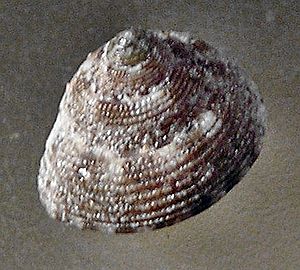Clanculus clangulus facts for kids
Quick facts for kids Clanculus clangulus |
|
|---|---|
 |
|
| A shell of Clanculus clangulus | |
| Scientific classification | |
| Synonyms | |
|
Clanculus clangulus is a type of small sea snail. It lives in the ocean and is a mollusk, which means it has a soft body, often protected by a shell. This snail belongs to a group called Trochidae, also known as top snails. They get their name because their shells often look like spinning tops.
What Does Clanculus clangulus Look Like?
This snail's shell is usually between 10 and 13 millimeters long. That's about half an inch! Its shell has a cone shape, like a tiny ice cream cone. The top part, called the spire, is often taller than on similar snails.
The shell can be brownish. But it's often a beautiful emerald green. The bottom part of the shell is usually much lighter. The top of the shell has reddish-pink marks. These marks look like flames. They don't go past the middle of the shell. The bottom of the shell is also dotted with the same reddish-pink color.
The spire usually gets thinner towards the very top. The tip is often a rose-pink color. The shell has about six whorls, which are the spiral turns. These turns are rounded. The last turn bends a bit towards the front.
The shell has about 18 spiral ridges. These ridges have tiny bumps, making them feel grainy. Between these main ridges, there are smaller bumpy lines. There are also sharp, slanted scratches. On older snails, these lines might look more even. The bottom of the shell has even finer, closer, bumpy lines.
The opening of the shell is called the aperture. It's slanted and has a somewhat square shape. The outer edge of the opening has folds inside. There's a small tooth-like bump near the top corner.
Where Does This Snail Live?
Clanculus clangulus is a special snail. It is found only in Australia. You can find it living off the coasts of New South Wales and Queensland. This means it's endemic to Australia, so it doesn't naturally live anywhere else in the world!

